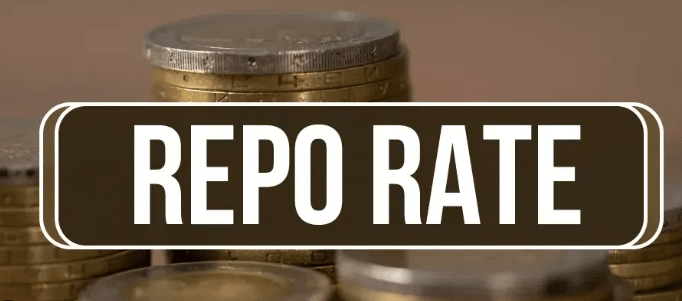Introduction
The Reserve Bank of India (RBI) announced its second bi-monthly monetary policy of the financial year 2024-25, maintaining the benchmark repo rate at 6.5% for the eighth consecutive time. This decision, made by the six-member Monetary Policy Committee (MPC) headed by Governor Shaktikanta Das, underscores a continued stance of ‘withdrawal of accommodation’. Alongside this decision, the RBI raised its GDP growth forecast for FY25 to 7.2%, reflecting a positive economic outlook.

Repo Rate Unchanged
Key Highlights of RBI’s Monetary Policy
Decision to Keep Repo Rate Unchanged
The RBI’s decision to keep the repo rate unchanged at 6.5% was made by a 4:2 majority within the MPC. This stance aims to balance inflation control with economic growth, reflecting the central bank’s cautious approach amidst global and domestic economic uncertainties.
GDP Growth Forecast
In a significant move, the RBI raised its GDP growth forecast for FY25 from 7% to 7.2%. This upward revision is attributed to improved economic indicators and a robust recovery in various sectors. The revised quarterly growth forecasts are:
- Q1FY25: 7.3% (up from 7.1%)
- Q2FY25: 7.2% (up from 6.9%)
- Q3FY25: 7.3% (up from 7%)
- Q4FY25: 7.2% (up from 7%)
Detailed Analysis of the Monetary Policy
Introduction to the Monetary Policy
The RBI’s bi-monthly monetary policy serves as a critical tool to manage the economy by controlling inflation and fostering economic growth. The policy includes decisions on key rates such as the repo rate, which influences borrowing costs and liquidity in the financial system.
Technical Specifications of the Policy
The current policy retains the repo rate at 6.5%, the rate at which the RBI lends to commercial banks. This rate has remained unchanged for eight consecutive policy reviews, reflecting the central bank’s steady approach.
Applications and Implications
The implications of maintaining the repo rate are far-reaching. For borrowers, this means stable loan interest rates, which can encourage investment and consumption. For the banking sector, it ensures predictable liquidity conditions, crucial for financial stability.
Benefits of the Policy Stance
Keeping the repo rate steady helps manage inflation and supports economic recovery. The RBI’s stance of ‘withdrawal of accommodation’ indicates a gradual tightening of liquidity to prevent overheating of the economy while fostering sustainable growth.
Challenges and Limitations
Potential Drawbacks
Despite the benefits, maintaining a steady repo rate has limitations. It might not be sufficient to address inflationary pressures if external shocks, such as rising commodity prices, occur. Additionally, prolonged stable rates could lead to complacency in financial markets.
Addressing Financial Sector Concerns
RBI Governor Shaktikanta Das emphasized the need to moderate unsecured loans and ensure transparency in fee structures by regulated entities. These steps aim to enhance financial stability and protect consumers.
Latest Innovations and Future Prospects
Recent Developments
The RBI’s decision to increase the GDP growth forecast to 7.2% signals confidence in the economic recovery. This optimism is backed by strong performance in various sectors, including manufacturing and services.
Future Outlook
Looking ahead, the RBI is likely to continue its cautious approach, balancing inflation control with growth promotion. Future policies will likely focus on enhancing financial stability, supporting economic recovery, and addressing emerging challenges.
Comparative Analysis with Other Central Banks
Global Perspective
Comparatively, central banks worldwide are grappling with similar challenges of inflation and growth management. The Federal Reserve, for instance, has adopted a more aggressive rate hike stance, contrasting with the RBI’s steady approach.
Lessons Learned
The RBI’s cautious stance provides a model for balancing inflation and growth, demonstrating the importance of context-specific policy decisions. This approach can serve as a reference for other central banks in similar economic environments.
User Guides and FAQs
How Does the Repo Rate Affect Consumers?
The repo rate directly influences the interest rates on loans and deposits. A stable repo rate means predictable borrowing costs, which can affect consumer spending and investment decisions.
What Is the ‘Withdrawal of Accommodation’ Stance?
This stance indicates a gradual tightening of liquidity in the financial system. It aims to prevent the economy from overheating while ensuring sufficient liquidity for growth.
Financial Sector Stability
Banking Sector Resilience
RBI Governor Shaktikanta Das highlighted that India’s banking system remains resilient, backed by improved asset quality and rising profitability. Non-Banking Financial Companies (NBFCs) have also shown strong financial performance in FY24, contributing to the overall robustness of the financial sector.
Dividend Transfer to Government
In his policy speech, Governor Das mentioned that the RBI transferred ₹2.11 lakh crore to the union government as a dividend. This substantial transfer underscores the central bank’s strong financial position and its role in supporting the government’s fiscal policies.
Inflation Forecasts
FY25 Inflation Estimates
The RBI retained its inflation estimates for FY25 at 4.5%. The quarterly estimates are as follows:
- Q1FY25: 4.9%
- Q2FY25: 3.8%
- Q3FY25: 4.6%
- Q4FY25: 4.5%
Economic Indicators and Analysis
Economic Recovery Indicators
The upward revision of the GDP growth forecast to 7.2% reflects positive trends in economic indicators. Sectors such as manufacturing, services, and agriculture have shown significant recovery, contributing to overall economic growth.
Challenges Ahead
Despite the positive outlook, challenges such as global economic uncertainties, geopolitical tensions, and domestic inflationary pressures remain. The RBI’s cautious approach aims to navigate these challenges while promoting sustainable growth.
Expert Insights
Quotes from Economists
Leading economists have praised the RBI’s balanced approach. Dr. Raghuram Rajan, former RBI Governor, noted, “The RBI’s decision to maintain the repo rate reflects a prudent approach to managing inflation while fostering growth.”
Financial Analysts’ Perspectives
Financial analysts have highlighted the importance of the RBI’s stance in ensuring economic stability. According to Arvind Subramanian, former Chief Economic Adviser, “The RBI’s policies are crucial in maintaining investor confidence and supporting long-term economic growth.”
Case Studies and Real-Life Implications
Impact on Small Businesses
The stable repo rate has provided small businesses with predictable borrowing costs, facilitating investment and expansion. Case studies from various sectors illustrate how businesses have benefited from the RBI’s monetary policies.
Consumer Behavior
Consumer spending has remained stable due to predictable interest rates on loans and credit facilities. This stability has supported overall economic activity, contributing to the positive GDP growth forecast.
Conclusion
The RBI’s decision to keep the repo rate unchanged at 6.5% and raise the GDP growth forecast to 7.2% reflects a balanced approach to managing the economy. By maintaining stability and fostering growth, the RBI aims to navigate the complexities of the current economic landscape. As we move forward, the central bank’s policies will continue to play a crucial role in shaping India’s economic trajectory.
FAQs
What is the repo rate? The repo rate is the rate at which the Reserve Bank of India lends money to commercial banks. It is a key monetary policy tool used to control inflation and regulate liquidity in the economy.
Why did the RBI keep the repo rate unchanged? The RBI decided to keep the repo rate unchanged at 6.5% to balance inflation control with economic growth. This decision reflects a cautious approach amidst global and domestic economic uncertainties.
What does ‘withdrawal of accommodation’ mean? ‘Withdrawal of accommodation’ refers to a gradual tightening of liquidity in the financial system. This stance aims to prevent the economy from overheating while ensuring sufficient liquidity for sustainable growth.
How will the unchanged repo rate affect consumers? An unchanged repo rate means stable interest rates on loans and deposits for consumers. This stability can encourage investment and spending, supporting overall economic activity.
What are the RBI’s inflation forecasts for FY25? The RBI retained its inflation estimates for FY25 at 4.5%. The quarterly estimates are:
- Q1FY25: 4.9%
- Q2FY25: 3.8%
- Q3FY25: 4.6%
- Q4FY25: 4.5%
Why did the RBI raise the GDP growth forecast for FY25? The RBI raised its GDP growth forecast for FY25 to 7.2% from 7% due to improved economic indicators and a robust recovery in various sectors. This upward revision reflects the central bank’s confidence in the economy’s positive trajectory.
How does the RBI’s policy impact the banking sector? The RBI’s policy ensures predictable liquidity conditions, crucial for financial stability. It also supports improved asset quality and profitability in the banking sector, contributing to overall financial sector resilience.
Conclusion
The Reserve Bank of India’s decision to maintain the repo rate at 6.5% and raise the GDP growth forecast for FY25 to 7.2% underscores its balanced approach to economic management. By ensuring stability and fostering growth, the RBI aims to navigate the complexities of the current economic landscape effectively. As we move forward, the central bank’s policies will continue to play a pivotal role in shaping India’s economic future.
Open Your Demat Account with Discount Brokers:
ZERODHA 1) : https://zerodha.com/open-account?c=EJ4366
Angelone 2) : https://tinyurl.com/2gloc3g6 or
Upstox3): https://link.upstox.com/9w4tNo1rK8au7VK47







